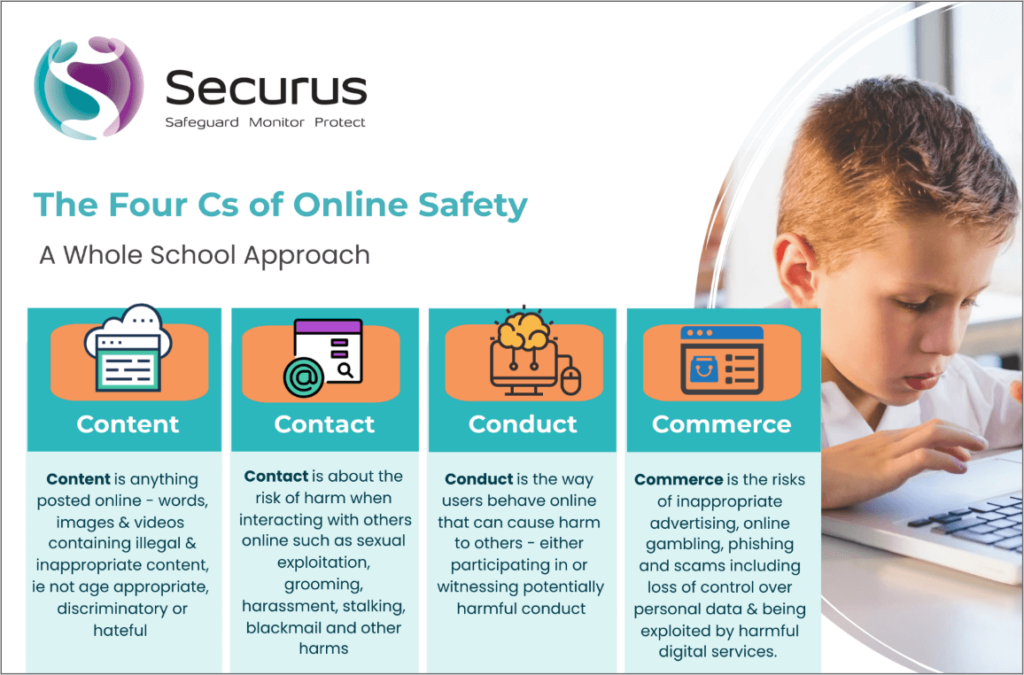Safeguarding in primary schools is about preventing harm and recognising and responding to risks and potential signs of abuse.
In primary schools, technology becomes an essential part of learning through education platforms, interactive games and communication tools, offering younger students exciting opportunities to become creative and acquire new skills whilst they navigate the digital world around them.
Primary age students are curious and eager to explore the online world but may lack the knowledge and experience of potential risks.
Protecting the wellbeing of every primary school student
School safeguarding leads play a crucial role to ensure that clear guidelines and safeguarding policy is in place and a detailed process is implemented to ensure students, staff and parents know how to report concerns when an incident occurs.
When using school devices and applications, this should include:
- Acceptable Use Policy (AUP) to outline what is and what is not acceptable behaviour online and across the school network
- Privacy Measures to show strict guidelines on what can be shared and what is stored by the school, including personal information
- Online Safety Education to teach students about digital harms – this includes fake news and content, sharing images and inappropriate material, grooming, hate speech, cyber bullying, radicalisation, exploitation and issues surrounding mental health and wellbeing
Unfortunately, even within a primary school environment students may experience various forms of abuse – including physical, emotional, sexual, or neglect. They may also face risks such as bullying, peer pressure, and coercion, which can be harder to identify.
For students who are ready to transition to secondary education, this is a beneficial time to prepare them for a new school experience where they must integrate with older children and the use of technology increases.
In Primary Schools, children are taught:
- that people sometimes behave differently online, including by pretending to be someone they are not.
- that the same principles apply to online relationships as to face-to-face relationships, including the importance of respect for others.
- the rules and principles for keeping safe online: how to recognise risks, harmful content and contact, and how to report them.
- how to critically consider their online friendships and sources of information.
Primary schools can follow the S.M.A.R.T rules as the basis for online safety:

|
Keep safe by being careful not to give out personal information – such as your full name, email address, phone number, home address, photos or school name – to people you are chatting with online. |

|
Meeting someone you have only been in contact with online can be dangerous. Only do so with your parents' or carers' permission and even then only when they can be present. |

|
Accepting emails, IM messages, or opening files, pictures or texts from people you don't know or trust can lead to problems – they may contain viruses or nasty messages! |

|
Information you find on the internet may not be true, or someone online may be lying about who they are. |

|
Tell your parent, carer or a trusted adult if someone or something makes you feel uncomfortable or worried, or if you or someone you know is being bullied online. You can report online abuse to the police at: www.thinkuknow.co.uk |

Download and print this A3 poster from Childnet for use in the classroom.
The 4 Cs of Online Safety for Primary School Students – A Whole School Approach
The overall framework for online safety risks fall into four categories: Content, Contact, Conduct and Commerce. This allows safeguarding leads to understand and identify potential digital dangers and can be illustrated in the following graphic:
For more information on Securus monitoring solutions for your primary school or multi-academy trust, please get in touch here or call us on 0330 124 1750
